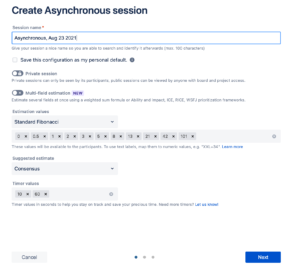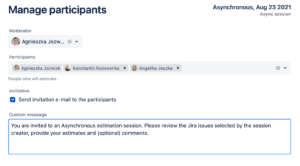Guest post by Spartez
Originally posted by Oleksii Kovalenko on August 23, 2021
A long time ago, Agile, Scrum, and Extreme Programming creators and supporters described numerous aspects of their frameworks in detail but didn’t give any instructions about one of the most important ceremonies: a backlog estimation. Teams knew that they have to estimate, but there were no instructions on doing it by the book. It became more clear only when Mike Cohn promoted Planning Poker.
Since 2002 Planning Poker evolved significantly: from a card game, where card decks were present in most of the IT companies’ offices, through numerous web services supporting Planning Poker players, or chatbots that replaced the Poker cards, to the services integrated with issue trackers, and finally, to apps like Agile Poker for Jira, integrated with project management systems.
Planning Poker eventually evolved into Asynchronous Poker that unblocked estimation for distributed teams or remote teams.
Today, I want to introduce you to a concept that some Agile Poker users call the next step in Planning Poker evolution – the Hybrid of Achyncronous and classic interactive Planning Poker. Let’s call it Hybrid Poker for the convenience of this blog post.
Planning Poker – The Golden Standard

Almost 20 years after its introduction, Planning Poker is still a golden standard for estimation in most Agile teams. It comes with a set of benefits that makes it tangible even now:
- it encourages group discussion and collaboration;
- it leaves team members with a shared understanding of every story;
- it has an engaging game flow;
- it is made for unbiased estimation to get everyone’s point of view;
- it allows team members to feel more committed to the project plan;
- it is relatively fast.
Although Planning Poker might seem like a fun way to estimate effort and work as a group, the process of the “game” or technique itself isn’t entirely intuitive. It can take a significant amount of time to figure out how to play the game in the first place, never mind coming up with accurate estimates.
Async Poker – A must-have for remote teams
Asynchronous (or Async) Poker was introduced in Agile Poker and quickly became popular due to a lack of alternatives for teams distributed in different timezones or even spread across various office locations.
Instead of finding a timeslot that suits all the participants (that might be challenging to achieve), players were able to provide estimates at their own pace, in a given timeframe, providing detailed comments explaining each personal estimate.
In the end, usually, the person responsible for planning submitted final estimates based on personal scores and comments from the team.

The peculiarity of Async Poker is that it is missing most of the Planning Poker benefits, which in fact some teams appreciate. Another problem is that during an interactive poker session moderator can add a new task or break a story into two, and the team will estimate it right away, but in the case of Async, a moderator should create a whole new session.
Hybrid Poker – The Next Generation Poker
Hybrid Poker is a combination of Async and Planning Poker. It is very popular among Agile Poker users, who previously used either Interactive or Async estimation sessions for their backlog estimation.
In three simple steps, the process of estimation in this hybrid mode looks like this:
- One of the team members creates an estimation session several days before the refinement or planning, specifying the session scope and sending invites to the team informing the team members about the scope and a deadline when they should submit their personal estimates.
- Team members estimate at their own pace at any time before a specific due date, additionally leaving comments explaining personal estimates or pointing out missing details. There is no additional discussion taking place at this point.
- When the final estimation session starts, the team gets together, can discuss the results of user stories if the consensus was not reached with the ability to interactively reset estimates and to carry out the voting.
Benefits for Planning Poker users. To picture such benefits, let’s imagine a team that used to do Planning Poker and comes to the final estimation or refinement session with all personal estimates provided and a complete understanding of issues details, or a moderator who has read through all the comments and was able to adjust some User Stories, break down the others and provide the missing information. In this case, the session is extremely fast because:
- while doing personal estimates, team members can swiftly go through the user stories because they are already familiar with them, while if we take the classic Planning Poker, they would have to wait for others who need more time to cast their estimate;
- participants of different seniority can spend proper time to understand each issue, not holding on or waiting for others, less experienced;
- the moderator provides extra information missing from tickets;
- the moderator can address participants’ comments with some additional actions, like breaking stories in two, adding missing acceptance criteria, providing extra feedback from business people, prior to the final estimation session; all the missing activities with the backlog like breaking down User Stories or creating new ones based on the comments are done;
- the team already provided personal estimates so only re-estimation to reach a consensus will take extra time.
Benefits for Async session users. Here, let’s imagine a team that used to do Async Poker and now can get together (maybe partially) for a short estimation session since the final estimation will be very quick now.
- all of the Planning Poker benefits mentioned above stay since the final estimation session takes place;
- personal estimates are faster because there is no need to be very detailed with estimation comments;
- the team can re-vote and reach a consensus;
- the team can estimate new stories or tasks right away;
What’s better, the Hybrid session is pretty flexible, so that you can adjust the process for your team’s needs.
Hybrid Poker session in Agile Poker
To run Planning Poker in Asynchronous mode in Agile Poker, follow these simple steps below.
1. Make sure you install Agile Poker for Jira first.

2. Navigate to a Jira project and select your board.
3. Click on Agile Poker from the board menu and create an Asynchronous session.

4. Specify participants, settings, and scope of the session. Optionally, send session invitation emails, don’t forget to mention a due date.

5. Wait for the teammates to provide personal estimates.
6. When the due date comes, enter the session and click on Review personal estimates.
7. Address questions, concerns, and suggestions from the comments of the colleagues.
8. Invite the team for a short Final estimation session by sharing the session link with them
9. Submit final estimates for the session scope. Don’t forget to reach a consensus by re-estimating issues during an interactive Poker game.




Over to you
Agile Poker for Jira will help you optimize your work and save hundreds of precious working hours. Are you ready to put it into play? Go to the Atlassian marketplace today and try Agile Poker for Jira for your team.
Let us know what you think about the Hybrid approach for Planning Poker and Asynchronous mode: support@spartez-software.com
Read Spartez’s original article here
Contact Design Industries